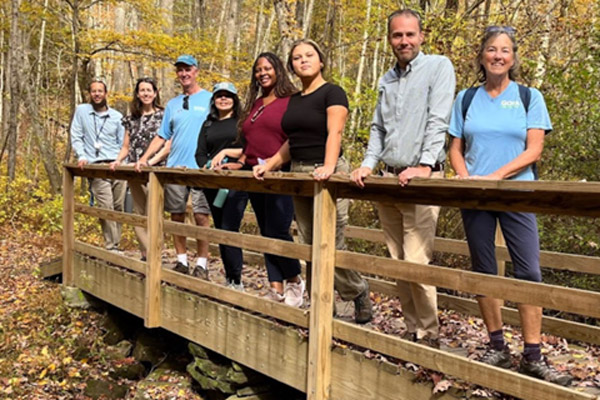
(l. to r.) Edith Fairgrieve, Priscilla Pratt, Sidney Van Zandt and Omar Allvord, at the GOSA annual meeting Oct. 12, 2006, in the Latham Chester Store, Noank, where they were honored for pioneering contributions to land conservation in Groton.
Priscilla W. Pratt is one of the two GOSA Founders who still sit on the board. [Post publication note: Priscilla died June 15, 2009.] She was corresponding secretary of the new organization that was formed in 1967 to raise funds to protect the 257-acre Haley Farm on Palmer Cove from development. In 1980, she was elected president, and subsequently she and her late husband, Charles Pratt, reinvigorated the organization by incorporating it with 501 (c) (3) status. They were responsible for finding and hiring the Crowley family, who have been cutting the Haley Farm fields for GOSA since 1986. After 32 years of persistent GOSA objections to many proposed developments of the Haley Farm’s upper 57 acres, which had been left out of the original purchase, the State DEP purchased the land, which adjoins the town high school. Priscilla has continued, in the role of GOSA chief executive, as the organization’s top strategist and point person in its fight to save open space and promote better development practices to protect our natural resources.
Sidney F. Van Zandt is the other of the two GOSA founders currently on the board. Sidney served as GOSA’s first president. Under Sidney’s leadership, GOSA raised the town’s portion of a town-state-federal open space grant to save the Haley Farm in 1970. She was co-chairman with Avery Point Prof. David McKain of the Environmental Education Committee (EEC) that put on the First Earth Day Program, set up the first recycling program in Groton, and published an environmental teaching guide for every elementary school teacher in the Groton school system.
In 1972, Sidney served as co-chairman, along with GOSA Director Omar Allvord, of the Bluff Point Advisory Council that was created by the Connecticut Legislature to come up with the highest and best use of Bluff Point. Charles Pratt served as press secretary to the Council. In 1974, The Bluff Point Coastal Reserve was formed by a legislative act signed by Governor Grasso. A bridge over the Amtrak tracks now connects Haley Farm and Bluff Point, which together add up to 1000+ acres of coastal parkland.
She was also a Director of the Connecticut Forest and Park Association, a member of the Governor’s Council of Environmental Quality, a Director of the Coastal Area Management Board, a founder and director of the eight-Town Mashantucket (now called Avalonia) Land Trust. She resigned from all her positions in 1980 to move to Virginia with her husband, Sandy, to build a steel boat, which they sailed around the world, returning in 1996. She is now back on the GOSA board. She is also a member of the Groton Utilities Watershed Source Protection Plan.
Omar Allvord is a GOSA director and a former GOSA treasurer. He is a former member of the Groton Town Council, the Groton Representative Town Meeting, and the Groton Beach and Park Commission. He is a charter member and former president of the Friends of Fort Griswold in Groton. In May, 2006, Omar won the Patriot Award from the Friends of Fort Griswold.
He was a co-chairman of the Bluff Point Advisory Council along with Director Sidney F. Van Zandt. (See above.) Omar is a WWII Navy veteran who saw duty on aircraft carriers in the North Atlantic. [Mr. Allvord died April 20, 2009].
Edith Fairgrieve is a director of GOSA and was a member of the Bluff Point Advisory Council. She was a founder of “TREES” [To Reassess Ecology-Environment-Safety], a community group dedicated to following governmental affairs in Groton to promote environmental quality. TREES initially was organized to defend residential rights and promote environmental awareness when the Connecticut Department of Transportation got an appropriation in 1970 to build the Allyn Street Connector in Mystic. Resident opposition, culminating in arrests on the day construction began, was insufficient to deal with a divided community backed up by the political clout of road builders and commercial interests favoring the Connector. However, TREES determined to stay in place to meet future challenges. Through the ensuing years, the group fielded development pressures; planning, zoning, wetlands, and historic issues; Allyn Street Connector issues; questions of open space protection and so forth. Leadership now is lacking to continue TREES, but Edith remains active in environmental affairs through her directorship in GOSA.

